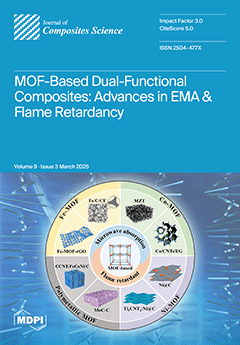As the communication band gradually approaches the terahertz (THz) range, there is an urgent need to explore materials with ideal dielectric properties for THz communication devices. Nevertheless, most polymers present a low dielectric constant (
Dk), and the regulation of their dielectric
[...] Read more.
As the communication band gradually approaches the terahertz (THz) range, there is an urgent need to explore materials with ideal dielectric properties for THz communication devices. Nevertheless, most polymers present a low dielectric constant (
Dk), and the regulation of their dielectric properties in the THz range has rarely been reported. In this work, the isotactic polypropylene (iPP)/α-Al
2O
3 whisker composites were synthesized and their THz dielectric parameters were optimized. The
Dk values increased from 2.23 to 3.13 with filler (α-Al
2O
3 whisker) concentration, ranging from 0 to 20 vol%, but were almost independent of the test frequency. The loss tangent (
Df) values presented an increasing tendency along with both filler concentrations and test frequency. All composites exhibited
Df values of less than 4.0 × 10
−3. Particularly, the dielectric properties of composites can be further regulated by adjusting the orientation direction of the whisker fillers. The orientation of the whisker fillers was adjusted via the injection molding method. Along the direction of the whisker orientation distribution, the composites exhibit higher
Dk values and lower
Df values. This work presented a schematic to design polymer composites with higher
Dk but controlled
Df in the THz range and is significant for the development of advanced materials-based THz devices.
Full article





